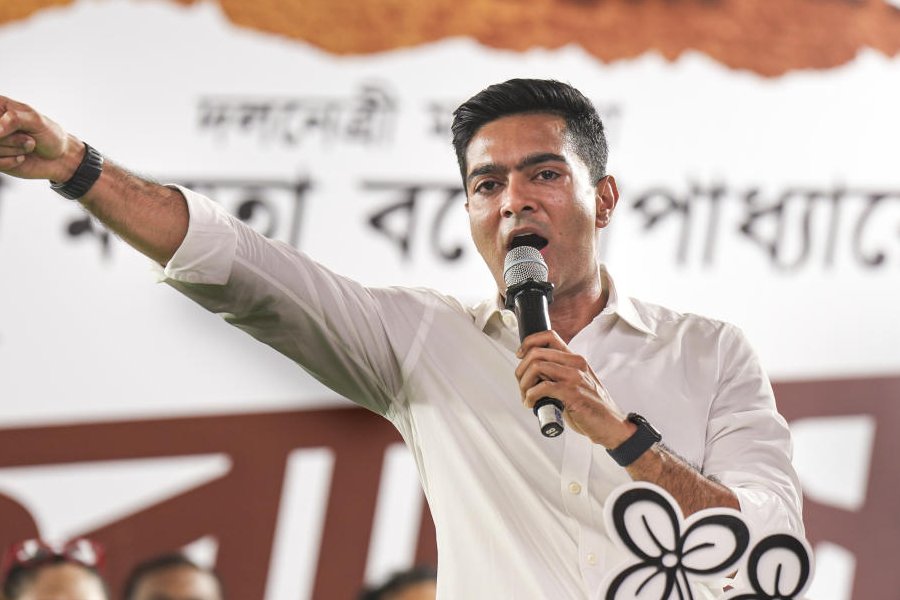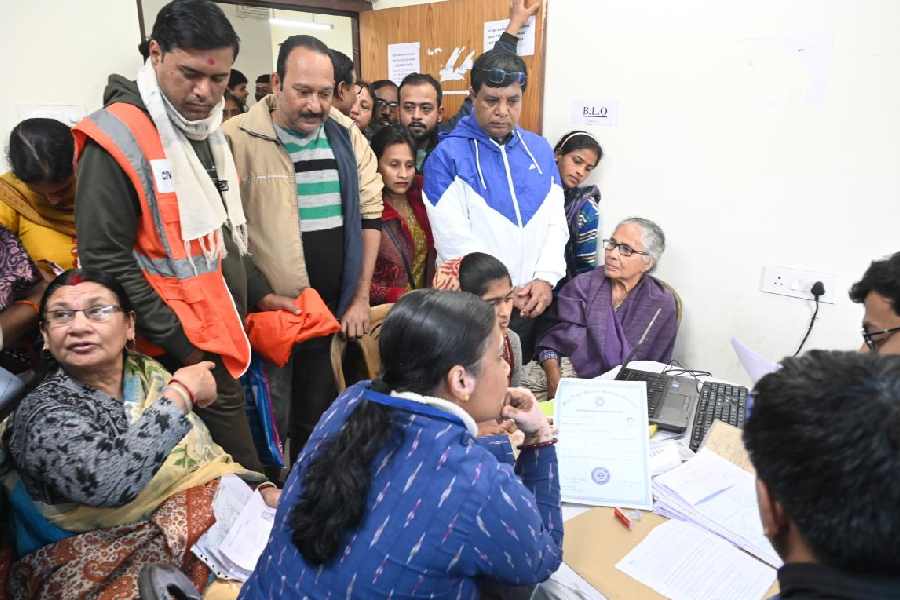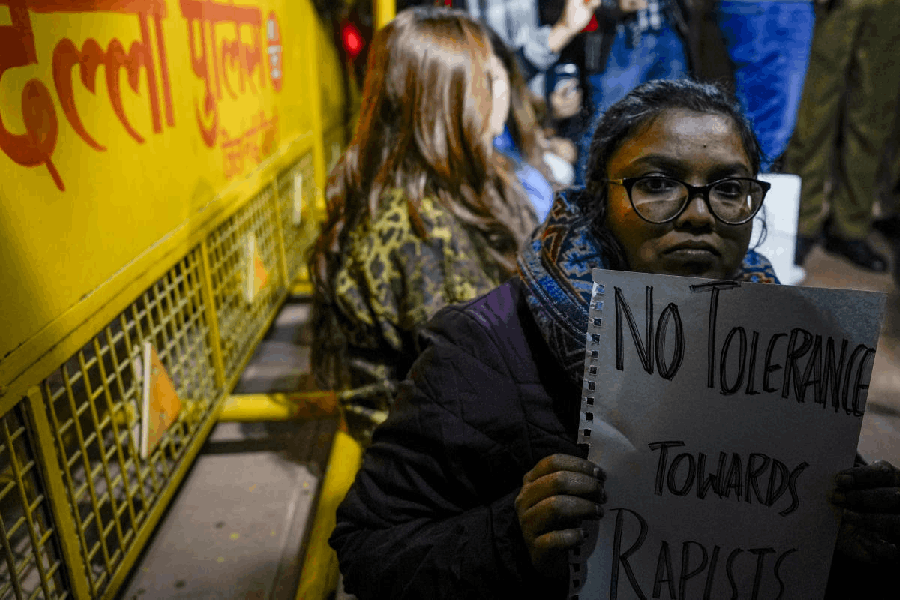 |
| Kartik Das Baul |
Raju Das Baul has barely turned 20 but he’s already a rising star in the world of folk music. The youthful Baul singer is doing shows around the country and has even sung in the opening sequence of a Tamil film alongside veteran musician M. Balamuralikrishna. At an international level, he acted and sang in a play, The Absent Lover, that was staged in London and Paris.
Kartik Das Baul is another audience favourite. Not only is he one of the Bauls singing for tabla maestro Tanmoy Bose’s folk fusion project Baul & Beyond, he’s part of the line-up of contemporary folk platform Oikyataan and he’s also on vocals for folk fusion band Bolepur Bluez, which made it to the quarter-finals of India’s Got Talent last year. Besides, he occasionally makes appearances for bands like Ashram and Strange Factory.
Raju and Kartik are part of an enthralling phenomenon — the rise and rise of Baul music. Baul music, one of Bengal’s spiritually and philosophically richest folk music forms, is making an amazing transition into the urban sphere with fans both in India and abroad. The result is that today you’ll find Bauls playing at festivals, appearing in movies and in theatre, and working in albums. “They play, they sing, they dance — all at once. They’re no less than rockstars,” says Tanmoy Bose, one of the first musicians in the city to work with the Bauls in his folk fusion project, Baul and Beyond.
But even some of the best known Baul singers live a life that’s a mix of modernity and tradition. Take Kartik, who lives in Guskhara in Birbhum district and who, during a good month, travels to Calcutta for an average of six to seven shows. At other times, he takes to madhukari — the Baul practice of singing for alms — on trains.
 |
| Golam Fakir (far right) is among the many Bauls who perform with Tanmoy Bose on his project, Baul & Beyond |
There’s no doubt, however, that the Bauls are going places. They are perhaps one of the few Indian folk art forms to get international attention. Interestingly, they were noticed abroad even before they made a mark in this country — and the level of interest has climbed even more dramatically in recent years.
Last year, Paban Das Baul and musician and writer Mimlu Sen (who’s also Paban’s wife and manager) collaborated with William Dalrymple for his Nine Lives book launch tour and performed at the Sydney Opera and the Barbican Theatre in London. In New York, they performed at the Asia Society. Paban is also working on new songs and recording with a French musician Pascal Vaucel.
Other Baul singers too are making their presence felt globally. Parvathy Baul has just returned to the country after appearing in shows in different corners of the world. She sang at The Tapestry of World Sacred Music in Singapore and also at a theatre and music festival in Cuba. And Uttam Das Baul performed in Bangladesh last year.
Then, there’s Kartik who, along with Oikyataan, performed at the Trees, Art, and Music Festival in Taiwan in 2009 and the Borneo Rainforest World Music Festival, in 2008. This year he will take the stage with Tanmoy Bose and Baul & Beyond in Norway in September. And Golam Fakir, who just got back from a folk music festival in Goa, will soon be heading to France, Netherlands and Morocco for a concert tour arranged by French traditional dance and music festival organisers Zaman Production.
Closer home too, the Bauls have been pulling in crowds with remarkable ease. Take, for instance, the annual Baul Fakir Utsav, in Shaktigarh, Jadavpur, that started out in a modest way in 2006 with around 50 Bauls. This year there were almost 100. “This festival means a lot to us because the organisers genuinely appreciate and understand our work,” says Golam Fakir, who recently scored a first of sorts by performing at the Lakmé Fashion Week.
In February this year, banglanatok dot com, which works with folk artists of Bengal, organised the Sufi Sutra music festival where 16 Bauls from Bengal and seven from Bangladesh shared the stage with Sufi musicians from across India, Bangladesh, Afghanistan, Jordan, Syria Iran, Egypt and Tajikistan. The three-day event attracted a crowd of 31,000.
 |
| The Baul Fakir Utsav this year had around 100 Bauls regale the audience with their music |
In other parts of the country too, the Bauls are becoming a visible presence. The Nagaur Sufi Music Festival in Rajasthan this year had Parvathy Baul perform for the first time. In Mumbai, production house Thinkerz, which organises Indian traditional performing art shows, also for the first time, featured Parvathy in Sarmast, a spiritual music programme in March this year. “The audience was spellbound by Parvathy singing and dancing with the nupur on her feet, ektara in one hand and the bama in the other,” recalls Rahul Kaikini, CEO and co-founder of Thinkerz.
Musicians and experts attribute the fascination for Baul music to various factors. “The universal message of love in Baul music attracts people looking for relief from life’s troubles,” says Parvathy. “Also, the lyrics and melodies are very modern and this appeals to young people looking for an identity that’s universal and not provincial,” adds Mimlu Sen.
And of course, the resurgence in folk forms across various genres has helped. “The urge to go back to one’s roots and, at the same time, to look for a new sound is creating a wider audience for Baul music,” says Manas Acharya of Calcutta Cycle, a ‘music artists’ collective’ that researches and performs traditional folk music.
In fact, Baul music is now reaching wider audiences because of its association with many musicians both in Calcutta and outside. One of the pioneers was, of course, Tanmoy Bose’s Baul and Beyond, which has Bauls like Kartik, Golam Fakir, Akkas Fakir, Lakkhan Das Baul and Krishna Das Baul, apart from Bangladeshi singer Anusheh Anadil. Anusheh’s own band Bangla also draws heavily from Baul Fakir music. Besides there’s Bonnie Chakraborty’s Oikyataan.
 |
| Parvathy Baul enthralled spectators at the Nagaur Sufi Music Festival, which featured Baul music for the first time this year. Pix by Ravi Gopalan Nair |
Or look at Malabika and Sanjay of Brahmakhyapa who do pure Baul music with jazz and Indian classical influences. Brahmakhyapa released their first album Bhromor in 2009. The record also got an online release and was made available in France, Italy and London. “We are now working on our next album, Shaaper Bish,” says Sanjay. Brahmakhyapa recently composed a track, for the Bengali comedy Bye Bye Bangkok.
Similarly, Manas Acharya’s Calcutta Cycle is a group of six musicians including Rabi Das Baul on vocals, percussions and rhythm. The group aims at “liberating music from the enclosures of studio and proscenium” and performing in “campuses, on the streets, coffee shops, market spaces, ferry ghats…and railway stations”.
And, of course, there’s Kunal Kundu’s Bolepur Bluez, with Kartik on vocals, that got national attention with its appearance on India’s Got Talent.
 |
“Performing with artistes like Bose, or even younger bands, not only brings the Bauls recognition, and hence more shows back home, it also boosts their confidence,” says Amitava Bhattacharya, founder director of banglanatok dot com. The organisation, which works with 350 Bauls of Nadia, helps create “a direct link between the musicians and the market.” banglanatok dot com also helped the Bauls start a resource centre in Nadia last year, where workshops and jam sessions with international musicians are common.
The constant exchange and collaboration between well-known musicians and the Bauls is bringing recognition in its wake. Percussionist Bickram Ghosh, for instance, had Gautam Das Baul and Sahaj Ma sing in his upcoming album Terra Groove. The album, made with foreign composer and musician Greg Ellis (of Iron Man, Matrix and 300 fame), blends African and Indian hand-played percussion, with a touch of electronic keyboards. Gautam has also sung for Ghosh in Suman Ghosh’s upcoming Mithun Chakraborty-starrer Nobel Chor. The 28-year-old Baul, who’s just auditioned for the current season of India’s Got Talent, will also be appearing as a judge on a Bengali TV reality show soon. Similarly, Arjun Khyapa, another Baul, acted and sang in a Zee Bangla serial recently. Meanwhile, Uttam Das Baul, travelled to New Zealand in 2009 to work in Holiwater, a documentary by Andrei Jewell that threads the Baul musical tradition with the philosophy of Indian thinkers and environmentalists.
 |
| Raju Das Baul (right) sang and made an appearance with folk singer Chinna Ponnu in Tamil film Kadhai |
Musicians outside Bengal are espousing Baul music as well. In Chennai, musician and composer Paul Jacob, roped in Raju Das Baul to sing in the Tamil film Kadhai with M. Balamurali- krishnan and folk artiste Chinna Ponnu. Raju also sang for Paul in a French film. In 2008, Paul organised the hugely successful Songs of the Madmen festival held in Pondicherry featuring veterans like Subal Das Baul and Lakkhan Das Baul.
The urban interest in Baul music has also opened up new spaces for the musicians. In 2010, Brahmakhyapa collaborated with French poet Pascal Teveny on two of his four albums. Teveny, who’s had a long association with Bengal and Bauls through iconic musician Gautam Chattopadhayay, also had Malabika sing French jazz and gypsy numbers apart from Baul songs.
And in 2009, Raju was cast in choreographer Preeti Vasudevan’s play The Absent Lover after she saw him sing in a show in Chennai. Says Vasudevan: “I wanted a story-telling type of music with a non-classical background, something raw and other-worldly.”
Despite the dismal state of music albums sales across genres, the greater visibility of Baul music has been a boon. Shuman Chattopadhyay of Kozmic Music says: “The quality of albums being produced hasn’t been affected thanks to the heightened interest in Baul music.” In fact, Swaraj Mazumdar, in-charge, Bengali music section, Music World, says there has been a 30 per cent rise in folk album sales in the store over the last two years.
Sufi Sutra saw the sale of almost 1,000 CDs recorded by banglanatok dot com. And the Baul Fakir Utsav sold out the 200 CDs of last year’s event. “We are now publishing archival material as well. This year we released Sanatan Das Baul’s work,” says Partha Majumder, one of the organisers.
 |
| Malabika and Sanjay of Brahmakhyapa recently collaborated with French poet Pascal Teveny on two albums |
The increased acceptance of this folk form in the ‘mainstream’ appears to be having an impact on the Bauls too. At one level, as singer-songwriter and folk music expert Moushumi Bhowmik, says: “The Bauls are making the most of the bigger market that is available now, and rightly so.”
At another level, there’s been community development as advocated by banglanatok dot com. According to Bhattacharya, drug abuse among Bauls has come down from 93 per cent in 2004 to seven per cent. “They’ve become aware that smoking hampers their voice,” says Bhattacharya. Besides, more of their kids go to school now — the figure’s gone up from 7 per cent in 2004 to 98 per cent.
Kartik Das Baul wraps it up aptly when he says “folk is the future.” And while he is cautious at the same time, (“it’s essential to stay true to our roots. We cannot become Bonnie or Tanmoy Bose”), musician Sam Mills, who introduced Paban Das Baul to the West in the 80s with his album Real Sugar, goes a step ahead: “I think in the future Baul music should be offensive to mainstream society, the way that blues rock, rap and reggae were offensive or separatist. If it’s not strong, what is it?”










